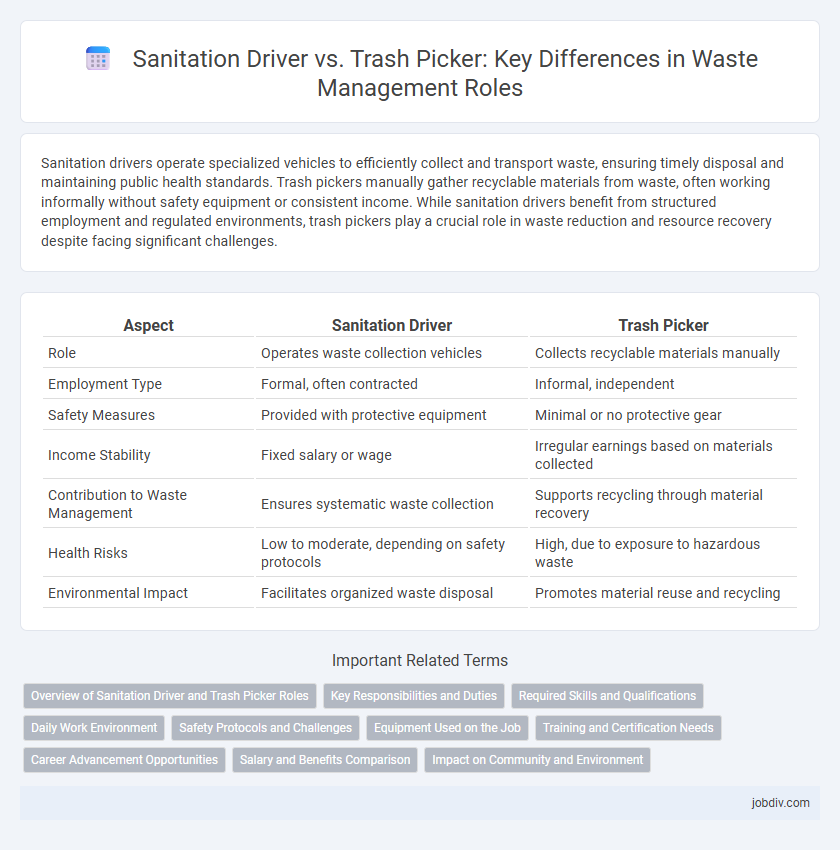Sanitation drivers operate specialized vehicles to efficiently collect and transport waste, ensuring timely disposal and maintaining public health standards. Trash pickers manually gather recyclable materials from waste, often working informally without safety equipment or consistent income. While sanitation drivers benefit from structured employment and regulated environments, trash pickers play a crucial role in waste reduction and resource recovery despite facing significant challenges.
Table of Comparison
| Aspect | Sanitation Driver | Trash Picker |
|---|---|---|
| Role | Operates waste collection vehicles | Collects recyclable materials manually |
| Employment Type | Formal, often contracted | Informal, independent |
| Safety Measures | Provided with protective equipment | Minimal or no protective gear |
| Income Stability | Fixed salary or wage | Irregular earnings based on materials collected |
| Contribution to Waste Management | Ensures systematic waste collection | Supports recycling through material recovery |
| Health Risks | Low to moderate, depending on safety protocols | High, due to exposure to hazardous waste |
| Environmental Impact | Facilitates organized waste disposal | Promotes material reuse and recycling |
Overview of Sanitation Driver and Trash Picker Roles
Sanitation drivers operate specialized vehicles designed for efficient waste collection and transportation, ensuring timely and hygienic removal of refuse from urban areas. Trash pickers manually collect recyclable and non-recyclable materials from streets, dumps, and landfills, often contributing to informal waste management systems. Both roles play crucial parts in maintaining public health and environmental sanitation, with sanitation drivers providing structured service and trash pickers supporting recycling efforts.
Key Responsibilities and Duties
Sanitation drivers operate waste collection vehicles, ensuring timely and efficient transport of garbage to disposal or recycling facilities, and maintain vehicle cleanliness and safety standards. Trash pickers manually collect recyclable and non-recyclable waste from streets, landfills, or dumpsites, sorting materials to maximize recovery and reduce landfill volume. Both roles are vital for effective waste management, with sanitation drivers focusing on logistical operations and trash pickers emphasizing material recovery and environmental sustainability.
Required Skills and Qualifications
Sanitation drivers require a commercial driver's license (CDL), knowledge of vehicle maintenance, and the ability to navigate routes efficiently to ensure timely waste collection. Trash pickers typically need physical stamina, familiarity with waste segregation, and awareness of health and safety protocols to handle diverse types of refuse. Both roles demand an understanding of environmental regulations, but sanitation drivers prioritize technical driving skills, while trash pickers focus on manual handling and sorting expertise.
Daily Work Environment
Sanitation drivers operate in structured settings, navigating city streets to efficiently collect and transport waste using specialized vehicles equipped with safety and hygiene features. Trash pickers often work informally in open dumpsites or urban streets, facing unpredictable conditions, exposure to hazardous materials, and lack of protective gear. The daily work environment for sanitation drivers is typically regulated and organized, contrasting sharply with the informal, high-risk conditions experienced by trash pickers.
Safety Protocols and Challenges
Sanitation drivers operate heavy machinery following strict safety protocols, including wearing high-visibility clothing, adhering to traffic regulations, and regular vehicle maintenance to prevent accidents during collection routes. Trash pickers face higher health and injury risks due to limited protective gear, exposure to hazardous waste, and lack of formal training in safe handling procedures. Both roles encounter challenges such as waste-related diseases and physical strain, but sanitation drivers benefit from structured safety measures rarely accessible to informal trash pickers.
Equipment Used on the Job
Sanitation drivers operate large garbage trucks equipped with hydraulic lifts, compactors, and GPS systems to ensure efficient waste collection and route management. Trash pickers typically rely on basic hand tools such as gloves, bags, and sometimes carts or baskets to manually collect recyclable materials from streets or dumpsites. The significant difference in equipment highlights the mechanized nature of sanitation drivers' work versus the manual, labor-intensive methods used by trash pickers.
Training and Certification Needs
Sanitation drivers require formal training and certification in vehicle operation, safety protocols, and waste management regulations to efficiently handle large waste collection vehicles. Trash pickers generally lack access to formal training programs, relying instead on practical experience and community knowledge, which limits their exposure to standardized safety and health practices. Implementing accessible certification programs for trash pickers can enhance their safety, improve waste sorting efficiency, and promote inclusion in formal waste management systems.
Career Advancement Opportunities
Sanitation drivers often benefit from structured career advancement paths within municipal or private waste management companies, including opportunities for promotion to supervisory or fleet management roles. Trash pickers, typically operating in informal sectors, face limited access to formal training, social benefits, or upward mobility, resulting in fewer opportunities for career growth. Investment in skill development and formal recognition can improve the economic prospects and job security for trash pickers.
Salary and Benefits Comparison
Sanitation drivers typically earn higher salaries than trash pickers, with average monthly wages ranging from $1,800 to $2,500 compared to $900 to $1,400 for trash pickers. Benefits for sanitation drivers often include health insurance, retirement plans, and paid leave, whereas trash pickers usually lack formal employment benefits and rely on informal or freelance work. The disparity in income and job security highlights the economic challenges faced by trash pickers despite their essential role in waste management.
Impact on Community and Environment
Sanitation drivers significantly improve community health by efficiently collecting and transporting waste to disposal sites, reducing the risk of disease and environmental pollution. Trash pickers contribute to informal recycling by salvaging reusable materials, which lowers landfill volumes and supports resource recovery, though their work often lacks safety measures and proper waste management infrastructure. Together, these roles complement waste systems but require integration for enhanced environmental sustainability and social protection.
Sanitation Driver vs Trash Picker Infographic

 jobdiv.com
jobdiv.com